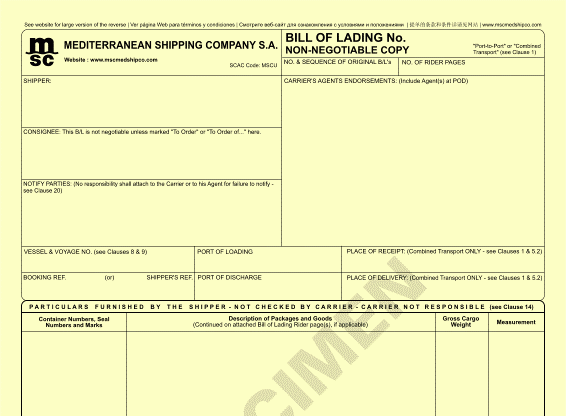
02 May WHAT IS B/L (BILL OF LADING)?
Are you a business person looking for the right definition to understand “what is Bill of Lading (B/L)?” We have the answers for you.
B/L is a crucial proof of transfer from the shipper or exporter to the carrier. It is a receipt and contract between the two parties confirming the delivery of goods transported by sea or air freight.
This document typically contains shipping details, such as weight, volume, and port arrival date. It’s important that all specific terms of the agreement must be agreed upon before signing off on your B/L.
To understand what this vital documentation means for international trade, keep reading!
What Is B/L?
A Bill of Lading (B/L) is a legal document issued by a carrier to a shipper, acknowledging the receipt of goods for shipment and outlining the terms and conditions of the transportation contract. It serves as both a receipt and a title of ownership until the goods are delivered to the consignee.

Understanding B/L
Understanding the B/L is essential for both shippers and carriers as it offers several benefits, including the following:
- Proof Of Delivery: B/L provides proof of delivery and acts as a receipt of goods, ensuring that the carrier delivers the goods to the correct recipient.
- Legal Protection: B/L provides legal protection to shippers and carriers in case of damage or loss of goods.
- Freight Payment: B/L indicates the agreed-upon rate between the shipper and carrier, which helps verify the freight charges.
- Inventory Control: B/L includes details of goods being transported, including their quantity, size, and weight, allowing shippers to keep track of their inventory.
- Compliance With Regulations: B/L also ensures compliance with international trade regulations and customs duties.

Key Terms In The Bill Of Lading
The B/L is a vital component of international trade and often proves that the carrier has received the goods in good condition. The document contains several key terms that should be understood by all parties involved in the transaction.
These terms include:
- Consignee
- Consignor
- Carrier
- Freight forwarder
- Destination port
- Duration of carriage.
Documents Needed For Bill Of Lading
A B/L is the evidence of an agreement between two parties. It is also used to transfer ownership of goods from the seller to the buyer.
Several documents are required to ensure the smooth processing of a Bill of Lading. These include a commercial invoice, packing list, and transport document.
The commercial invoice details the seller’s name and address, the buyer’s name and address, and the price and quantity of goods being shipped.
The packing list provides a detailed description of the imported items, including their weight and dimensions.

How To Use A Bill Of Lading
A B/L is a crucial document in international shipping. It serves as a contract between the shipper and carrier, outlining the terms of transportation and providing a receipt of goods.
When a shipment is loaded onto a vessel, the page issues an original B/L, proving cargo ownership. The consignee or receiver can only obtain the goods by presenting the original B/L to the carrier.
To use a bill of lading, ensure that the documents match the freight and check for any discrepancies in the information. It is vital to keep a copy of the bill of lading for your records.
Always ensure the original bill of lading is handed over before the cargo leaves the port. Using a bill of lading will ensure a successful and secure shipment.
Wrapping Up
In a nutshell, the Bill of Lading (B/L) is an essential and valuable international trade and shipping document. It serves as a vital contract between the shipper and the carrier, outlining the terms and conditions of the transportation of goods.
Understanding the B/L’s contents provides numerous benefits, including clarity in shipment details, legal protection, efficient dispute resolution, smoother customs clearance, and improved risk management.
Moreover, it enhances negotiation power, aids financial planning, and helps reduce fraud and theft risks. Hence, a comprehensive grasp of the B/L empowers stakeholders to navigate the complexities of global trade with confidence and efficiency.

No Comments